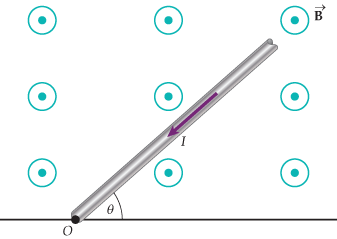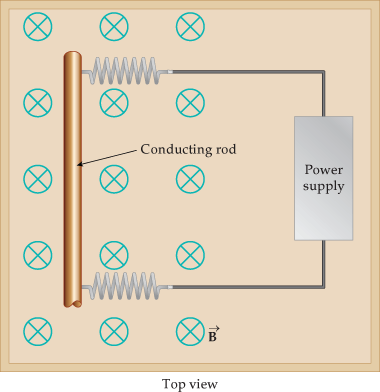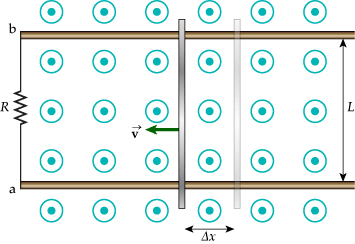1)As shown in the figure, a uniform conducting rod of length 0.40 m and mass 0.075 kg is in rotational equilibrium about the hinge at point O. A uniform magnetic field of 0.23 T is directed out of the plane of the page, perpendicular to the rod. Due to a battery and wires not shown, there is a current of 4.0 A in the rod directed toward point O. Determine the angle θ.

2)As shown in the figure, a conducting rod with a length of 0.79 m is placed on a horizontal frictionless surface and attached to a power supply by two springs, each with a spring constant of 81 N/m. The springs are initially at their equilibrium length and are in a region where there is a uniform magnetic field of 0.17 T that is perpendicular to the frictionless surface when the power supply supplies a current that causes the wire to move in such a direction that the two springs are stretched.
 (a) Determine the stretch of each spring, if the current through the rod is 11 A.
3)A conducting rod of length L = 30.5 cm slides over two horizontal metal bars with a constant speed v to the left through a distance Δx in a time Δt. The entire set up is in a region of uniform magnetic field of magnitude 1.30 T that is directed perpendicular to the rods and out ofthe page.
(a) Determine the stretch of each spring, if the current through the rod is 11 A.
3)A conducting rod of length L = 30.5 cm slides over two horizontal metal bars with a constant speed v to the left through a distance Δx in a time Δt. The entire set up is in a region of uniform magnetic field of magnitude 1.30 T that is directed perpendicular to the rods and out ofthe page.
 (a) If the induced emf has a magnitude of 1.00 V, what is the speed with which the rod moves?
4)An MRI technician moves his hand from a region of very low magnetic field strength into an MRI scanner's 2.00-T field with his fingers pointing in the direction of the field.
(a) Find the average emf induced in his wedding ring, given its diameter is 2.34 cm and assuming it takes 0.222 s to move it into the field.
(a) If the induced emf has a magnitude of 1.00 V, what is the speed with which the rod moves?
4)An MRI technician moves his hand from a region of very low magnetic field strength into an MRI scanner's 2.00-T field with his fingers pointing in the direction of the field.
(a) Find the average emf induced in his wedding ring, given its diameter is 2.34 cm and assuming it takes 0.222 s to move it into the field.
(b) If the resistance of the ring is 1.00 mΩ, how much heat will be transferred to the ring during this time?
1)As shown in the figure, a uniform conducting rod of length 0.40 m and mass 0.075 kg is in rotational equilibrium about the hinge at point O. A uniform magnetic field of 0.23 T is directed out of the plane of the page, perpendicular to the rod. Due to a battery and wires not shown, there is a current of 4.0 A in the rod directed toward point O. Determine the angle θ.

2)As shown in the figure, a conducting rod with a length of 0.79 m is placed on a horizontal frictionless surface and attached to a power supply by two springs, each with a spring constant of 81 N/m. The springs are initially at their equilibrium length and are in a region where there is a uniform magnetic field of 0.17 T that is perpendicular to the frictionless surface when the power supply supplies a current that causes the wire to move in such a direction that the two springs are stretched.


(b) If the resistance of the ring is 1.00 mΩ, how much heat will be transferred to the ring during this time?
